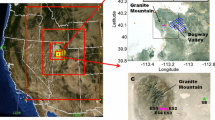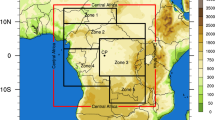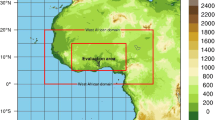Abstract
The objective of the study is to evaluate operational mesoscale meteorological model atmospheric boundary-layer (ABL) outputs for use in the Hazard Prediction Assessment Capability (HPAC)/Second-Order Closure Integrated Puff (SCIPUFF) transport and dispersion model. HPAC uses the meteorological models’ routine simulations of surface buoyancy flux, winds, and mixing depth to derive the profiles of ABL turbulence. The Fifth-Generation Pennsylvania State University/National Center for Atmospheric Research Mesoscale Model (MM5) and the Weather Research and Forecast-Nonhydrostatic Mesoscale Model (WRF-NMM) ABL outputs and the HPAC ABL parameterisations are compared with observations during the International H2O Project (IHOP). The meteorological models’ configurations are not specially designed research versions for this study but rather are intended to be representative of what may be used operationally and thus have relatively coarse lowest vertical layer thicknesses of 59 and 36 m, respectively. The meteorological models’ simulations of mixing depth are in good agreement (±20%) with observations on most afternoons. Wind speed errors of 1 or 2 ms−1 are found, typical of those found in other studies, with larger errors occurring when the simulated centre of a low-pressure system is misplaced in time or space. The hourly variation of turbulent kinetic energy (TKE) is well-simulated during the daytime, although there is a meteorological model underprediction bias of about 20–40%. At night, WRF-NMM shows fair agreement with observations, and MM5 sometimes produces a very small default TKE value because of the stable boundary-layer parameterisation that is used. The HPAC TKE parameterisation is usually a factor of 5–10 high at night, primarily due to the fact that the meteorological model wind-speed output is at a height of 30 m for MM5 and 18 m for WRF-NMM, which is often well above the stable mixing depth. It is concluded that, before meteorological model TKE fields can be confidently used by HPAC, it would help to improve vertical resolution near the surface, say to 10 m or less, and it would be good to improve the ABL parameterisations for shallow stable conditions.
Similar content being viewed by others
References
Ballard SP, Golding BW, Smith RNB (1991) Mesoscale model experimental forecasts of the Haar of northeast Scotland. Mon Weather Rev 119: 2107–2123
Benjamin KJ, Seaman NL (1985) A simple scheme for objective analyses in curved flow. Mon Weather Rev 113: 1184–1198
Blackadar AK (1962) The vertical distribution of wind and turbulent exchange in a neutral atmosphere. J Geophys Res 67: 3095–3102
Chen F, Dudhia J (2001) Coupling an advanced land surface-hydrology model with the Penn State-NCAR MM5 modeling system. Part I: Model implementation and sensitivity. Mon Weather Rev 129: 569–585
Chen F, Manning KW, LeMone MA, Trier SB, Alfieri JG, Roberts R, Tewari M, Niyogi D, Horst TW, Onley SP, Basara JB, Blanken PD (2007) Description and evaluation of the characteristics of the NCAR high-resolution land data assimilation system. J Appl Meteorol Clim 46: 694–713
Cox R, Bauer BL, Smith T (1998) A mesoscale model intercomparison. Bull Amer Meteorol Soc 79: 265–283
Deng A, Stauffer DR (2006) On improving 4-km mesoscale model simulations. J Appl Meteorol Clim 43: 1864–1886
DTRA (2004) HPAC version 4.04.011 (DVD containing model and accompanying data and document files). DTRA, Ft. Belvoir, VA
Dudhia J (1993) A nonhydrostatic version of the Penn State/NCAR mesoscale model: validation tests and simulation of an Atlantic cyclone and cold front. Mon Weather Rev 121: 1493–1513
Grell GA, Dudhia J, Stauffer DR (1995) A description of the fifth-generation Penn State/NCAR Mesoscale Model (MM5). NCAR/TN-398+STR. National Center for Atmospheric Research, Boulder, CO, 122 pp
Hanna SR, Yang R (2001) Evaluations of mesoscale model predictions of near-surface winds, temperature gradients, and mixing depths. J Appl Meteorol 40: 1095–1104
Janjic ZI (1996a) The Mellor-Yamada level 2.5 scheme in the NCEP Eta model. In: 11th conference on NWP, Norfolk, VA, 19–23 Aug 1996. American Meteorological Society, Boston, pp 333–334
Janjic ZI (1996b) The surface layer in the NCEP Eta model. In: 11th conference on NWP, Norfolk, VA. American Meteorological Society, Boston, pp 354–355
Janjic ZI (2001) Nonsingular implementation of the Mellor-Yamada Level 2.5 scheme in the NCEP Meso model. NCEP Office note no. 437, pp 61
Janjic ZI (2003) A nonhydrostatic model based on a new approach. Meteorol Atmos Phys 82:271–285. Online: http://dx.doi.org/10.1007/s00703-001-0587-6
Kain JS, Fritsch JM (1990) A one-dimensional entraining/detraining plume model. J Atmos Sci 47: 2784–2802
Kang SL (2007) The effects of mesoscale surface heterogeneity on the fair-weather convective atmospheric boundary layer. Ph.D. Dissertation, Pennsylvania State University, 200 pp. Available from the Department of Meteorology, The Pennsylvania State University, University Park, PA
Kang SL, Davis KJ, LeMone MA (2007) Observations of ABL structures over a heterogeneous land surface during IHOP-2002. J Hydrometeorol 8: 221–244
LeMone MA, Chen F, Alfieri JG, Cuenca RH, Hagimoto Y, Blanken P, Niyogi D, Kang S, Davis K, Grossman RL (2007a) NCAR/CU surface, soil, and vegetation observations during the International H2O Project 2002 field campaign. Bull Amer Meteorol Soc 88: 65–81
LeMone MA, Chen F, Alfieri JG, Tewari M, Geerts B, Miao Q, Grossman RL, Coulter RL (2007b) Influence of land cover and soil moisture on the horizontal distribution of sensible and latent heat fluxes in Southeast Kansas during IHOP-2002 and CASES-97. J Hydrometeorol 8: 68–87
Mlawer EJ, Taubman SJ, Brown PD, Iacono MJ, Clough SA (1997) Radiative transfer for inhomogeneous atmosphere: RRTM, a validated correlated-K model for the longwave. J Geophys Res 102(D14): 16663–16682
Pielke RA Sr (1998) The need to assess uncertainty in air quality evaluations. Atmos Environ 32: 1467–1468
Pielke RA Sr, Uliasz M (1998) Use of meteorological models as input to regional and mesoscale air quality models—limitations and strengths. Atmos Environ 32: 1455–1466
Reen BP (2007) Data assimilation strategies and land-surface heterogeneity effects in the planetary boundary layer. Ph.D. Dissertation. Pennsylvania State University, 246 pp. Available from the Department of Meteorology, The Pennsylvania State University, University Park, PA, http://etda.libraries.psu.edu/
Seaman NL (2000) Meteorological modeling for air quality assessments. Atmos Environ 34: 2231–2259
Seaman NL, Stauffer DR, Lario-Gibbs AL (1995) A multi-scale four-dimensional data assimilation system applied to the San Jouquin Valley during SARMAP. Part I: Modeling design and basic performance characteristics. J Appl Meteorol 34: 1739–1761
Shafran PC, Seaman NL, Gayno GA (2000) Evaluation of numerical predictions of boundary layer structure during the Lake Michigan Ozone Study. J Appl Meteorol 39: 412–426
Skamarock WC (2004) Evaluating mesoscale NWP models using kinetic energy spectra. Mon Weather Rev 132: 3019–3032
Stauffer DR, Seaman NL (1994) Multiscale four-dimensional data assimilation. J Appl Meteorol 33: 416–434
Stauffer DR, Muñoz RC, Seaman NL (1999) In-cloud turbulence and explicit microphysics in the MM5. In: 9th PSU/NCAR MM5 modeling system users’ workshop, NCAR, Boulder, CO, pp 177–180
Stauffer DR, Seaman NL, Hunter GK, Leidner SM, Lario-Gibbs AM, Tanrikulu S (2000) A field-coherence technique for meteorological field-program design for air-quality studies. Part I: Description and interpretation. J Appl Meteorol 39: 297–316
Stauffer DR, Muñoz RC, Seaman NL (2001) On the importance of saturation effects in the turbulence scheme of a mesoscale model. In: 9th AMS conference on mesoscale processes, Ft. Lauderdale, FL, 30 July–2 August, pp 1–5
Stauffer DR, Hunter GK, Deng A, Zielonka JR, Tinklepaugh K, Hayes P, Kiley C (2007) On the role of atmospheric data assimilation and model resolution on model forecast accuracy for the Torino Winter Olympics. In: 22nd conference on weather analysis and forecasting/18th conference on NWP, Park City, Utah. American Meteorological Society. Extended abstract 11A.6, available at http://ams.confex.com/ams/22WAF18NWP/techprogram/paper_124791.htm
Stauffer DR, Gaudet BJ, Seaman NL, Wyngaard JC, Mahrt L, Richardson S (2009) Sub-kilometer numerical predictions in the nocturnal stable boundary layer. In: 23rd American Meteorological Society conference on weather analysis and forecasting/19th American Meteorological Society conference on numerical weather prediction, Omaha, Nebraska, USA, 1–5 June, 18B.4
Sykes RI, Parker S, Henn D, Chowdhury B (2007) SCIPUFF version 2.3 technical documentation. L-3 Titan Corp, Princeton, NJ, 336 pp
Tanrikulu S, Stauffer DR, Seaman NL, Ranzieri AJ (2000) A field-coherence technique for meteorological field-program design for air-quality studies. Part II: Evaluation in the San Joaquin Valley. J Appl Meteorol 39: 317–334
Weckwerth TM, Parsons DB, Koch SE, Moore JA, LeMone MA, Demoz BB, Flamant C, Geerts B, Wang J, Feltz WF (2004) An overview of the International H2O Project (IHOP-2002) and some preliminary highlights. Bull Amer Meteorol Soc 85: 253–277
Yamada T (1977) A numerical experiment on pollutant dispersion in a horizontally homogenous atmospheric boundary layer. Atmos Environ 11: 1015–1024
Zhang D, Anthes RA (1982) A high-resolution model of the Planetary Boundary Layer—sensitivity tests and comparisons with SESAME-79 data. J Appl Meteorol 21: 1594–1607
Author information
Authors and Affiliations
Corresponding author
Rights and permissions
About this article
Cite this article
Hanna, S.R., Reen, B., Hendrick, E. et al. Comparison of Observed, MM5 and WRF-NMM Model-Simulated, and HPAC-Assumed Boundary-Layer Meteorological Variables for 3 Days During the IHOP Field Experiment. Boundary-Layer Meteorol 134, 285–306 (2010). https://doi.org/10.1007/s10546-009-9446-7
Received:
Accepted:
Published:
Issue Date:
DOI: https://doi.org/10.1007/s10546-009-9446-7




